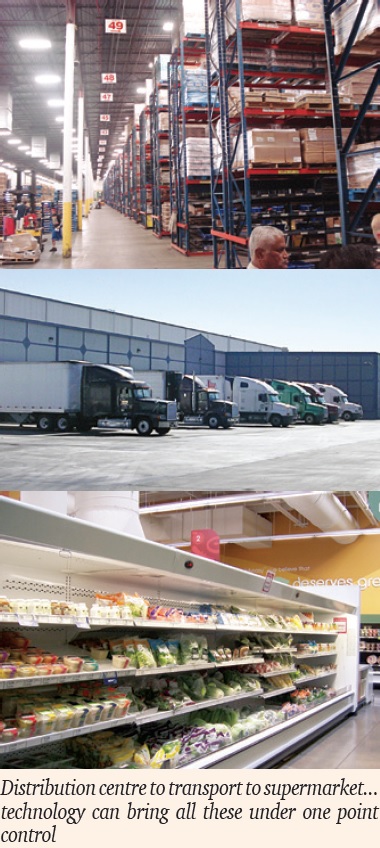News Details
Can we Bring IoT to Cold Chain?
24 July 2017
By Harshal Surange and Arvind Surange
Introduction
In the world of controls and automation, the sky is the limit today. How far one can go is limited only by one’s budget and imagination. Nowadays, automation has reached such levels that almost the entire system of a plant can be controlled literally from the palm of your hand (meaning your mobile). Software compatible with mobile applications are being developed to control the system.
In the world of controls and automation, the sky is the limit today. How far one can go is limited only by one’s budget and imagination. Nowadays, automation has reached such levels that almost the entire system of a plant can be controlled literally from the palm of your hand (meaning your mobile). Software compatible with mobile applications are being developed to control the system.
What is ioT?
Internet of Things (IoT) is the inter-networking of physical devices (also referred to as ‘connected devices’ and ‘smart devices’), vehicles, buildings and other items embedded with electronics, software, sensors, actuators and network connectivity that enable these objects to collect and exchange data. Simply put, this is basically the concept of connecting any device with an on-off switch to the Internet (and/or to each other). These ‘Things’, when provided with unique identifiers, have the ability to transfer data over a network without requiring human-to-human or human-tocomputer interaction. Typically, IoT covers a variety of protocols, domains, and applications. The interconnection of these embedded devices (including smart objects), is expected to usher in automation in nearly all fields, while also enabling advanced applications like smart grids, and expanding to areas such as smart cities. Going forward, we will soon be moving into an era of ‘smart’ cold chain, which would be in addition to the ‘green’ cold chain that we have been taking about for more than a decade now. IoT is poised to transform Building Management System (BMS) as used in the building sector, which is increasinglybeing used in cold chain projects today. It is not only lowering the cost of BMS by using inexpensive sensors and low-powered networks, but also using a host of value- added services by uncovering new opportunities for energy management, safety and security, lighting, HVACR and non-HVACR equipment monitoring, and control in real time.
Internet of Things (IoT) is the inter-networking of physical devices (also referred to as ‘connected devices’ and ‘smart devices’), vehicles, buildings and other items embedded with electronics, software, sensors, actuators and network connectivity that enable these objects to collect and exchange data. Simply put, this is basically the concept of connecting any device with an on-off switch to the Internet (and/or to each other). These ‘Things’, when provided with unique identifiers, have the ability to transfer data over a network without requiring human-to-human or human-tocomputer interaction. Typically, IoT covers a variety of protocols, domains, and applications. The interconnection of these embedded devices (including smart objects), is expected to usher in automation in nearly all fields, while also enabling advanced applications like smart grids, and expanding to areas such as smart cities. Going forward, we will soon be moving into an era of ‘smart’ cold chain, which would be in addition to the ‘green’ cold chain that we have been taking about for more than a decade now. IoT is poised to transform Building Management System (BMS) as used in the building sector, which is increasinglybeing used in cold chain projects today. It is not only lowering the cost of BMS by using inexpensive sensors and low-powered networks, but also using a host of value- added services by uncovering new opportunities for energy management, safety and security, lighting, HVACR and non-HVACR equipment monitoring, and control in real time.
IoT and Cold Chain
Moving on from buildings in the cold chain to internal processes, IoT applications are being planned in cold storages and cold chain projects. Currently, software companies are working out warehouse management solutions (WMS) and their integration with e-commerce websites and software for the cold chain industry. WMS is a software application that supports dayto- day operations and enables centralised management of tasks with accurate tracking of inventory up to the product or pallet level, storage optimisation and speedy retrieval. WMS, specially designed for cold storages, are being built to achieve business benefits like:
• Segregation of inventory as per the cold chain company’s locations, chambers and layout
• Better storage visibility and storage location recommendations
• Automated retrieval process resulting in faster response time and fewer picking errors
• Accurate logging of inward and outward transactions
• View of ‘in-progress’ transactions at any point of time
• Optimised storage management resulting in energy savings
• Accurate reporting with analytics over reports
• Remote data visibility (over the Internet and to clients, if desired)
• Improved customer service
• Accurate billing with automated provisions for value-added services, credit limits, payment reminders, etc.
• Minimised paperwork
• Efficient and effective labour management
• Tax management including various entry taxes, etc.
Moving on from buildings in the cold chain to internal processes, IoT applications are being planned in cold storages and cold chain projects. Currently, software companies are working out warehouse management solutions (WMS) and their integration with e-commerce websites and software for the cold chain industry. WMS is a software application that supports dayto- day operations and enables centralised management of tasks with accurate tracking of inventory up to the product or pallet level, storage optimisation and speedy retrieval. WMS, specially designed for cold storages, are being built to achieve business benefits like:
• Segregation of inventory as per the cold chain company’s locations, chambers and layout
• Better storage visibility and storage location recommendations
• Automated retrieval process resulting in faster response time and fewer picking errors
• Accurate logging of inward and outward transactions
• View of ‘in-progress’ transactions at any point of time
• Optimised storage management resulting in energy savings
• Accurate reporting with analytics over reports
• Remote data visibility (over the Internet and to clients, if desired)
• Improved customer service
• Accurate billing with automated provisions for value-added services, credit limits, payment reminders, etc.
• Minimised paperwork
• Efficient and effective labour management
• Tax management including various entry taxes, etc.
Overall, we are at an automation level at cold storages where complete automation of a system is now possible and, going forward, we will be able to have software that can even tell whether a given product should be stored along with another product and what should be the ideal location of the incoming product considering the other products stored. Since the information on where other products are stored would be system-driven, the system itself would know where everything is and where a give product should be stored. Integrating WMS with cold chain logistic software like Transport Management System (TMS) and Dock Management System (DMS) will enable an end-to-end process automation for cold chain companies. As of today, WMS requires an IT operator to input or scan details of products or pallets into the system. If this is automated by IoT sensors integrated with the product talking directly to WMS, we will move to a comprehensive automated system. Taking this a step further, software are being built to allow e-tailers and online users on e-commerce platforms to place orders on cold chain companies directly over the Internet. Online food deliveries (fresh and frozen) are seen as the next big market by the e-commerce industry. These software will help boost business for both e-commerce and cold chain industries. IoT has already started finding its place in the cold chain logistics sector. Small, IoT-enabled sensors that constantly monitor the surface temperature of food are being built. These sensors enable logistics players to track and monitor product temperature in real time. The data is sent via mobile networks to a cloud database and then distributed over mobile phones using apps and mobile sites, thus continuously monitoring perishable goods through the supply chain. This reporting is customisable, allowing the user to decide the interval of reporting of each package, type of alerts and range of temperature for each item. This allows users to build their own analytics over the logistics history, and results in reliability and reduced logistical errors. Overall, it would not be inappropriate to say that IoT can create a symbiosis between BMS, WMS, DMS, TMS, cold logistics and e-commerce to give the user a complete single point control over all aspects related to cold chain management.
Cold Chain Events
ISHRAE Kolkata Chapter conducted a special session on Cold Chain Prospects and Problems, where Arvind Surange was invited to be a part of the panel discussion. Director of Fisheries (West Bengal) and the President of WB Cold Storage Association also participated. Refcon, which has till now been organised between Pune and Chennai, has now been created as a brand and will take place at various places in India. Currently, Refcon is planned at Pune, Chennai, Ahmedabad, Thane, Jaipur and Gurgaon, among other venues. Other Chapters have also expressed interest and we urge ISHRAEites to use the resources of ISHRAE Refrigeration Committee and ensure that their Chapter gets the best programs during the year. Harshal Surange, who continues to be the National Chair of the Committee, can be contacted any time for information. ISHRAE Pune Chapter has planned a series of technical lectures by renowned industry experts on a monthly basis. In June, a tech talk by Arvind Surange on Emerging Trends in refrigeration and Introduction to Cold Chain has been organised. By the time this issue reaches your hands, the Cold Chain Awards by Kamikaze would have been distributed. We are happy to inform readers that our organisation, ACR Project Consultants Pvt. Ltd., has received the award for Green Cold Chain Project. We have been talking about Green cold chain for many years now, and this will spur us to continue to green the cold chain as the world continues to green its buildings.
ISHRAE Kolkata Chapter conducted a special session on Cold Chain Prospects and Problems, where Arvind Surange was invited to be a part of the panel discussion. Director of Fisheries (West Bengal) and the President of WB Cold Storage Association also participated. Refcon, which has till now been organised between Pune and Chennai, has now been created as a brand and will take place at various places in India. Currently, Refcon is planned at Pune, Chennai, Ahmedabad, Thane, Jaipur and Gurgaon, among other venues. Other Chapters have also expressed interest and we urge ISHRAEites to use the resources of ISHRAE Refrigeration Committee and ensure that their Chapter gets the best programs during the year. Harshal Surange, who continues to be the National Chair of the Committee, can be contacted any time for information. ISHRAE Pune Chapter has planned a series of technical lectures by renowned industry experts on a monthly basis. In June, a tech talk by Arvind Surange on Emerging Trends in refrigeration and Introduction to Cold Chain has been organised. By the time this issue reaches your hands, the Cold Chain Awards by Kamikaze would have been distributed. We are happy to inform readers that our organisation, ACR Project Consultants Pvt. Ltd., has received the award for Green Cold Chain Project. We have been talking about Green cold chain for many years now, and this will spur us to continue to green the cold chain as the world continues to green its buildings.
Acknowledgement
The authors acknowledge the inputs of Aditi Surange on IoT and its impact on the cold chain industry.
The authors acknowledge the inputs of Aditi Surange on IoT and its impact on the cold chain industry.
Disclaimer: The information provided within this publication / eBook/ content is for general informational purposes only. While we try to keep the information up-to-date and correct, there are no representations or warranties, express or implied, about the completeness, accuracy, reliability, suitability or availability with respect to the information, products, services, or related graphics contained in this publication / eBook/ content for any purpose. Any use of this information is at your own risk.
 Youth
Youth
 Women
Women
 Research for Ishrae
Research for Ishrae







